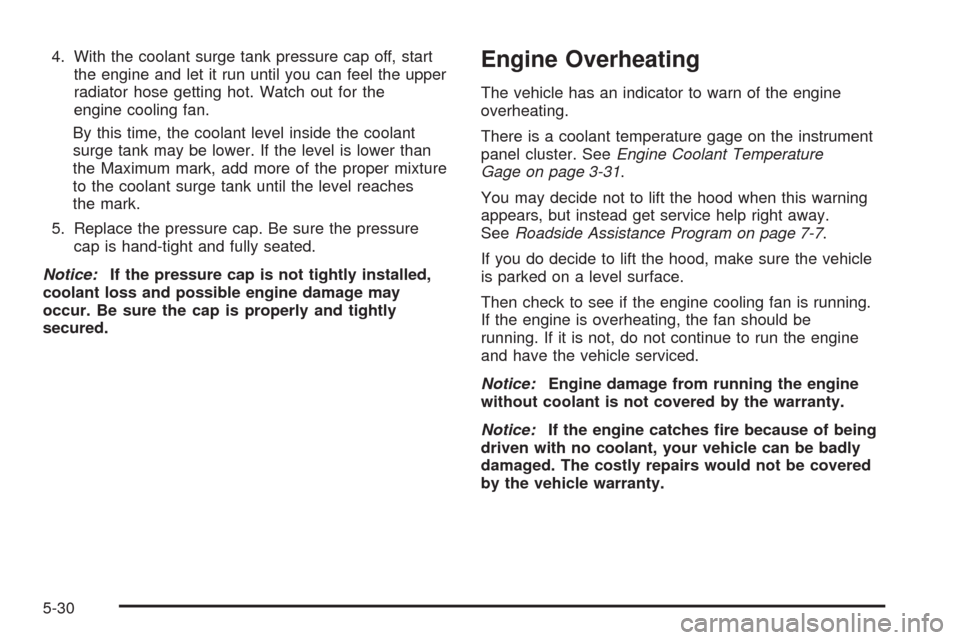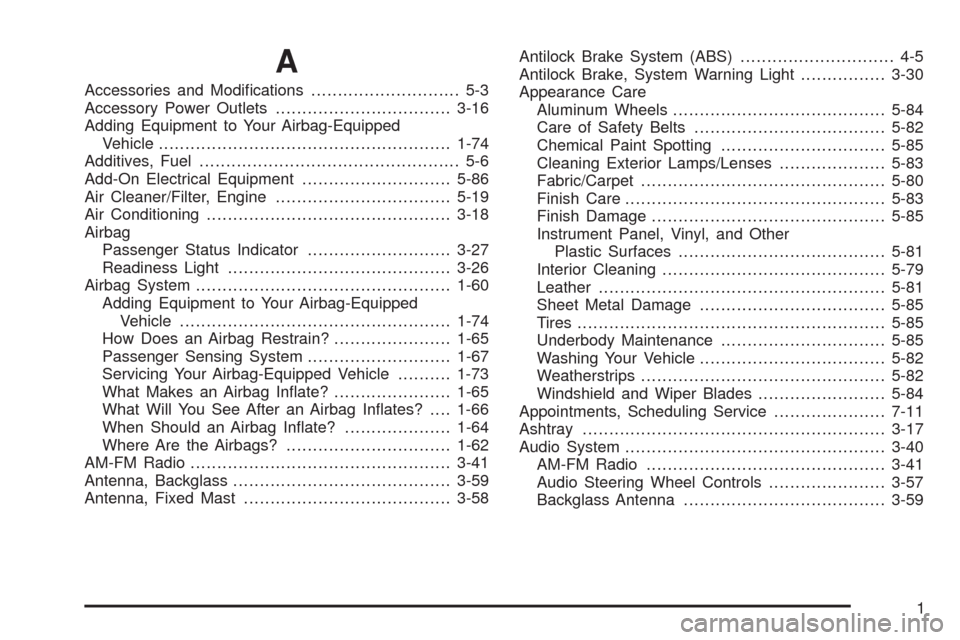2009 CHEVROLET AVEO service indicator
[x] Cancel search: service indicatorPage 157 of 354

Fuel Gage
The fuel gage indicates about how much fuel is left
when the ignition is turned to ON/RUN.
When the tank nears empty, the low fuel warning
light will come on. There is still a little fuel left,
but the vehicle’s fuel tank should be �lled soon.
SeeLow Fuel Warning Light on page 3-38for more
information.
An arrow on the fuel gage indicates the side of the
vehicle the fuel door is located.Here are four things that some owners ask about.
None of these show a problem with the fuel gage:
At the service station, the gas pump shuts off before
the gage reads full.
It takes a little more or less fuel to �ll up than the
gage indicated. For example, the gage may have
indicated the tank was half full, but it actually took a
little more or less than half the tank’s capacity to
�ll the tank.
The indicator moves a little when turning a corner
or speeding up.
The gage goes back to empty when the ignition is
turned off. United StatesCanada
3-37
Page 215 of 354

Also, your dealer/retailer has additives that will help
correct and prevent most deposit-related problems.
Gasolines containing oxygenates, such as ethers and
ethanol, and reformulated gasolines might be available
in your area. We recommend that you use these
gasolines, if they comply with the speci�cations
described earlier. However, E85 (85% ethanol) and
other fuels containing more than 10% ethanol must
not be used in vehicles that were not designed for
those fuels.
Notice:This vehicle was not designed for fuel that
contains methanol. Do not use fuel containing
methanol. It can corrode metal parts in the fuel
system and also damage plastic and rubber parts.
That damage would not be covered under the
vehicle warranty.Some gasolines that are not reformulated for low
emissions can contain an octane-enhancing additive
called methylcyclopentadienyl manganese tricarbonyl
(MMT); ask the attendant where you buy gasoline
whether the fuel contains MMT. We recommend against
the use of such gasolines. Fuels containing MMT can
reduce the life of spark plugs and the performance of the
emission control system could be affected. The
malfunction indicator lamp might turn on. If this occurs,
return to your dealer/retailer for service.
Fuels in Foreign Countries
If you plan on driving in another country outside the
United States or Canada, the proper fuel might be hard
to �nd. Never use leaded gasoline or any other fuel
not recommended in the previous text on fuel. Costly
repairs caused by use of improper fuel would not
be covered by the vehicle warranty.
To check the fuel availability, ask an auto club, or
contact a major oil company that does business in the
country where you will be driving.
5-7
Page 238 of 354

4. With the coolant surge tank pressure cap off, start
the engine and let it run until you can feel the upper
radiator hose getting hot. Watch out for the
engine cooling fan.
By this time, the coolant level inside the coolant
surge tank may be lower. If the level is lower than
the Maximum mark, add more of the proper mixture
to the coolant surge tank until the level reaches
the mark.
5. Replace the pressure cap. Be sure the pressure
cap is hand-tight and fully seated.
Notice:If the pressure cap is not tightly installed,
coolant loss and possible engine damage may
occur. Be sure the cap is properly and tightly
secured.Engine Overheating
The vehicle has an indicator to warn of the engine
overheating.
There is a coolant temperature gage on the instrument
panel cluster. SeeEngine Coolant Temperature
Gage on page 3-31.
You may decide not to lift the hood when this warning
appears, but instead get service help right away.
SeeRoadside Assistance Program on page 7-7.
If you do decide to lift the hood, make sure the vehicle
is parked on a level surface.
Then check to see if the engine cooling fan is running.
If the engine is overheating, the fan should be
running. If it is not, do not continue to run the engine
and have the vehicle serviced.
Notice:Engine damage from running the engine
without coolant is not covered by the warranty.
Notice:If the engine catches �re because of being
driven with no coolant, your vehicle can be badly
damaged. The costly repairs would not be covered
by the vehicle warranty.
5-30
Page 244 of 354

Brake Wear
This vehicle has front disc brakes and could have rear
drum brakes or rear disc brakes.
Disc brake pads have built-in wear indicators that make a
high-pitched warning sound when the brake pads are
worn and new pads are needed. The sound can come
and go or be heard all the time the vehicle is moving,
except when applying the brake pedal �rmly.
{CAUTION:
The brake wear warning sound means that soon the
brakes will not work well. That could lead to an
accident. When the brake wear warning sound is
heard, have the vehicle serviced.
Notice:Continuing to drive with worn-out brake
pads could result in costly brake repair.
Some driving conditions or climates can cause a brake
squeal when the brakes are �rst applied or lightly applied.
This does not mean something is wrong with the brakes.
Properly torqued wheel nuts are necessary to help
prevent brake pulsation. When tires are rotated, inspect
brake pads for wear and evenly tighten wheel nuts in the
proper sequence to torque speci�cations inCapacities
and Specifications on page 5-93.If the vehicle has rear drum brakes, they do not have
wear indicators, but if a rear brake rubbing noise is
heard, have the rear brake linings inspected
immediately. Rear brake drums should be removed and
inspected each time the tires are removed for rotation
or changing. When the front brake pads are replaced,
have the rear brakes inspected, too.
Brake linings should always be replaced as complete
axle sets.
Brake Pedal Travel
See your dealer/retailer if the brake pedal does not
return to normal height, or if there is a rapid increase in
pedal travel. This could be a sign that brake service
might be required.
Brake Adjustment
Every moderate brake stop, the disc brakes adjust for
wear. If rarely making moderate or heavier brake stops,
the brakes might not adjust correctly. Very carefully
making a few moderate brake stops about every
1,000 miles (1 600 km) will adjust the brakes properly.
If the vehicle has rear drum brakes and the brake pedal
goes down farther than normal, the rear drum brakes
might need adjustment. Adjust them by backing up and
�rmly applying the brakes a few times.
5-36
Page 269 of 354

The tire pressure warning light may come on in cool
weather when the vehicle is �rst started, and then turn
off as you start to drive. This could be an early
indicator that the tire pressures are getting low and
need to be in�ated to the proper pressure.
A Tire and Loading Information label, attached to your
vehicle, shows the size of your vehicle’s original
equipment tires and the correct in�ation pressure for your
vehicle’s tires when they are cold. SeeLoading the
Vehicle on page 4-16, for an example of the tire
information label and its location on your vehicle. Also
seeInflation - Tire Pressure on page 5-57.
Your vehicle’s TPMS system can warn you about a low
tire pressure condition but it does not replace normal
tire maintenance. SeeTire Inspection and Rotation
on page 5-62andTires on page 5-51.
Notice:Liquid tire sealants could damage the Tire
Pressure Monitor System (TPMS) sensors. Sensor
damage caused by using a tire sealant is not
covered by your warranty. Do not use liquid tire
sealants.TPMS Malfunction Light
The TPMS will not function properly if one or more of
the TPMS sensors are missing or inoperable. When the
system detects a malfunction, the low tire warning
light �ashes for about one minute and then stays on for
the remainder of the ignition cycle. The low tire
warning light comes on at each ignition cycle until the
problem is corrected. Some of the conditions that
can cause the malfunction light to come on are:
One of the road tires has been replaced with the
spare tire. The spare tire does not have a TPMS
sensor. The TPMS malfunction light and DIC
message should go off once you re-install the road
tire containing the TPMS sensor.
One or more TPMS sensors are missing or
damaged. The TPMS malfunction light should go off
when the TPMS sensors are installed and the sensor
matching process is performed successfully. See
your dealer/retailer for service.
Replacement tires or wheels do not match your
vehicle’s original equipment tires or wheels. Tires
and wheels other than those recommended for your
vehicle could prevent the TPMS from functioning
properly. SeeBuying New Tires on page 5-64.
Operating electronic devices or being near facilities
using radio wave frequencies similar to the TPMS
could cause the TPMS sensors to malfunction.
5-61
Page 343 of 354

A
Accessories and Modi�cations............................ 5-3
Accessory Power Outlets.................................3-16
Adding Equipment to Your Airbag-Equipped
Vehicle.......................................................1-74
Additives, Fuel................................................. 5-6
Add-On Electrical Equipment............................5-86
Air Cleaner/Filter, Engine.................................5-19
Air Conditioning..............................................3-18
Airbag
Passenger Status Indicator...........................3-27
Readiness Light..........................................3-26
Airbag System................................................1-60
Adding Equipment to Your Airbag-Equipped
Vehicle...................................................1-74
How Does an Airbag Restrain?......................1-65
Passenger Sensing System...........................1-67
Servicing Your Airbag-Equipped Vehicle..........1-73
What Makes an Airbag In�ate?......................1-65
What Will You See After an Airbag In�ates?....1-66
When Should an Airbag In�ate?....................1-64
Where Are the Airbags?...............................1-62
AM-FM Radio.................................................3-41
Antenna, Backglass.........................................3-59
Antenna, Fixed Mast.......................................3-58Antilock Brake System (ABS)............................. 4-5
Antilock Brake, System Warning Light................3-30
Appearance Care
Aluminum Wheels........................................5-84
Care of Safety Belts....................................5-82
Chemical Paint Spotting...............................5-85
Cleaning Exterior Lamps/Lenses....................5-83
Fabric/Carpet..............................................5-80
Finish Care.................................................5-83
Finish Damage............................................5-85
Instrument Panel, Vinyl, and Other
Plastic Surfaces.......................................5-81
Interior Cleaning..........................................5-79
Leather......................................................5-81
Sheet Metal Damage...................................5-85
Tires..........................................................5-85
Underbody Maintenance...............................5-85
Washing Your Vehicle...................................5-82
Weatherstrips..............................................5-82
Windshield and Wiper Blades........................5-84
Appointments, Scheduling Service.....................7-11
Ashtray.........................................................3-17
Audio System.................................................3-40
AM-FM Radio.............................................3-41
Audio Steering Wheel Controls......................3-57
Backglass Antenna......................................3-59
1
Page 346 of 354

D
Daytime Running Lamps Indicator Light.............3-36
Defensive Driving............................................. 4-2
Disc, MP3......................................................3-54
Doing Your Own Service Work........................... 5-4
Dome Lamp ...................................................3-16
Door
Ajar Light...................................................3-36
Central Door Unlocking System....................... 2-7
Door Ajar Reminder....................................... 2-7
Locks.......................................................... 2-6
Rear Door Security Locks............................... 2-7
Driver
Seat Height Adjuster...................................... 1-5
Driving
At Night.....................................................4-10
Before a Long Trip......................................4-11
Defensive..................................................... 4-2
Drunken....................................................... 4-3
Highway Hypnosis.......................................4-12
Hill and Mountain Roads..............................4-12
In Rain and on Wet Roads...........................4-10
Rocking Your Vehicle to Get it Out.................4-16
Winter........................................................4-13
Driving for Better Fuel Economy......................... 4-2
E
EDR .............................................................7-18
Electrical System
Add-On Equipment......................................5-86
Engine Compartment Fuse Block...................5-89
Fuses and Circuit Breakers...........................5-87
Headlamp Wiring.........................................5-87
Instrument Panel Fuse Block.........................5-88
Power Windows and Other Power Options......5-87
Windshield Wiper Fuses...............................5-87
Engine
Air Cleaner/Filter.........................................5-19
Change Engine Oil Light...............................3-35
Check and Service Engine Soon Lamp...........3-32
Coolant......................................................5-25
Coolant Temperature Gage...........................3-31
Drive Belt Routing.......................................6-16
Engine Compartment Overview......................5-14
Exhaust.....................................................2-32
Oil .............................................................5-16
Oil Life System...........................................5-18
Overheating................................................5-30
Starting......................................................2-19
Engine Heater................................................2-21
Event Data Recorders.....................................7-19
Extender, Safety Belt.......................................1-34
Exterior Lamps...............................................3-13
4
Page 349 of 354

Liftgate
Carbon Monoxide........................................2-10
Light
Airbag Readiness........................................3-26
Antilock Brake System (ABS) Warning............3-30
Brake System Warning.................................3-28
Change Engine Oil......................................3-35
Charging System.........................................3-28
Cruise Control.............................................3-36
Daytime Running Lamps Indicator..................3-36
Door Ajar...................................................3-36
Fog Lamp ..................................................3-35
Highbeam On.............................................3-36
Hold Mode .................................................3-30
Low Fuel Warning.......................................3-38
Oil Pressure...............................................3-34
Passenger Airbag Status Indicator..................3-27
Safety Belt Reminders..................................3-26
Tire Pressure..............................................3-31
Up-Shift.....................................................3-28
Lights
Exterior Lamps............................................3-13
Flash-to-Pass............................................... 3-8
High/Low Beam Changer................................ 3-8
Loading Your Vehicle.......................................4-16
Locks
Central Door Unlocking System....................... 2-7
Door ........................................................... 2-6
Rear Door Security Locks............................... 2-7
Loss of Control................................................ 4-8Low Fuel Warning Light...................................3-38
Lower Anchors and Tethers for Children.............1-46
Lumbar
Manual Controls............................................ 1-5
M
Maintenance Schedule
Additional Required Services........................... 6-6
At Each Fuel Fill.........................................6-10
At Least Once a Month................................6-10
At Least Once a Year..................................6-11
Introduction.................................................. 6-2
Maintenance Footnotes.................................. 6-8
Maintenance Record....................................6-17
Maintenance Replacement Parts....................6-15
Maintenance Requirements............................. 6-2
Owner Checks and Services........................... 6-9
Recommended Fluids and Lubricants.............6-13
Scheduled Maintenance................................. 6-4
Using.......................................................... 6-2
Your Vehicle and the Environment................... 6-2
Malfunction Indicator Lamp...............................3-32
Manual Lumbar Controls.................................... 1-5
Manual Seats................................................... 1-4
Manual Transmission
Fluid..........................................................5-23
Operation...................................................2-26
Manual Windows............................................2-12
7